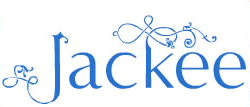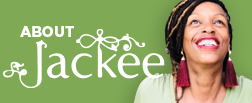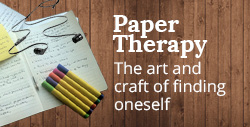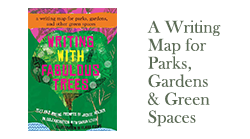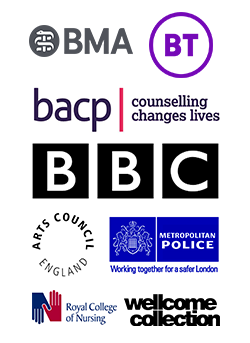Coaching
Sunday, December 28th, 2014
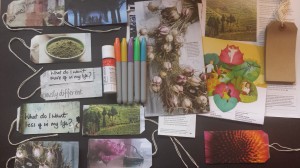
Photo credit: Jackee Holder 2014
How about some paper therapy to take you into the new year?
Make your own hand made journal writing prompts or inspirational writing quotes to get you started and to keep going so you won’t run out of things to write about in the new year.
You will need:
Photo credit Jackee Holder 2014
- Packet of brown or coloured luggage tags (12-24 individual tags)
- Glue stuck and pair of scissors
- Print off the list of writing prompts or inspirational writing quotes at the bottom of these instructions.
- Pen if you are going to hand write the journal prompts or quotes
How it works:
- Leaf through your magazines and tear out pages with images, pictures and words that catch your attention.
- You might also like to tear out pages with colour as these make contrasting backdrops for some of your images.
- Bear in mind that one side of the tag will include the words of the journal prompt or quote and the other side will focus more on the image.
- If there are images you like photocopying the original and keeping the original as a master copy.
- Collage your luggage tags using the images and words collected from your magazines.
- Hand write or paste each of the writing prompts or quoted on one side of the luggage tag. Use a permanent pen or marker like a Sharpie if hand writing your prompts.
- If you are gifting your journal prompts bundle them together with string or ribbon.
- Alternatively place each journal prompt or quote in-between the pages of a blank journal. Keep them in an envelope or a special box.
Hope you’ve noticed these also make great personalized gift tags!
Journal Quotes
- What I really, really want?
- Things would have been much better had I …
- The thing that stood out from today?
- What I didn’t do that I could have done?
- The feelings and emotions I am noticing …
- If there was nothing holding me back the things I would be trying out, doing or saying would be …
- When I was a child I dreamed of becoming a …
- 10 things I’ve learned from my life to date?
- The things I know I’m not writing about are …
- A time in my life when I was really powerful? How could I transfer my way of being from that moment into now?
- What advice would your inner mentor give you right now?
- Describe your year twelve months on from today.
- The holiest memory of your life so far? What contributed to this feeling?
- The bravest thing you have ever done …
- If you could go back and change one thing from your past what would it be?
- Who made you feel good this week and why?
- How do you feel about where you live?
- What would you do if you knew you could not fail?
- What’s your wildest dream of achieving in this lifetime?
- How can I bring more joy into my life?
- What do I want more of in my life?
- What do I want less of in my life?
- What is my secret ambition?
- What do I want to be remembered for at the end of my life?
- What are my top three strengths?
- Where do I want to be a year from now? Five years from now? Ten years from now? Twenty years from now?
- What does my ideal living environment look like?
- What can I do right now that would make the greatest difference in my life?
- What am I tolerating/putting up with?
- What childhood dreams have I been neglecting?
- Where have I been giving my power over to others? What do I need to do in order to regain my power?
Journal Writing Inspiration Quotes
Therapeutic journal writing implies the conscious intent and deliberate attempts to write in ways, which will produce change, healing and growth.
- Kate Thompson
Ink runs in our veins and tells the world what we are like.
- Phillip Hensher
Writing remains unchanged until revisited – Gillie Bolton
By writing and honouring the contents of your journals you become the guardians, historians and creators of the self on and off the page.
- Jackee Holder
Journal writing is my new paper therapy. It is one of the most inexpensive and accessible therapies around.
- Jackee Holder
Writing changes lives and lives, are changed by writing
- Jackee Holder
Journaling is like whispering to one’s self and listening at the same time.
- Mina Murray (Dracula)
Letters are marvelous vehicles whether they are sendable or not.
- Gillie Bolton
For nearly 30 years I’ve had the same therapist. I’ve called on my therapist at 3am, on my wedding day, on a cold and lonely Christmas, on a Bora Bora beach. I can tell the therapist absolutely anything.
- Kathleen Adams
I couldn’t trust a therapist the way I would a piece of paper. Paper’s always there to re-read or re-write. Once you’ve said something you can’t unsay it, but with a piece of writing you can. You don’t ever have to share it. You can burn it if you want.
- Kathleen Adams
“The small interior voice that keeps urging me “ Physician heal thyself” and (that) as a result (I’m) committed to this journal, this ongoing prescription for self regeneration.”
- Gillie Bolton, p39 Write Yourself (2007, p125)
A journal siphons private fears and dramas onto the page, allowing others to focus their emotional energies on the patient. Long term it provides an invaluable reminder of human resilience. – Alexandra Johnson
Trust that the bore bending your ear on the plane or the ranting taxi driver on the ride home never kept a journal. Their egotism leaks out publicly instead. You become their journal, a live blank page, held hostage in a seat. Think of journals as a safe, private way to have it siphoned of, rethought, vented
- Alexandra Johnson
Catch the censor off guard. Write at odd moments in even odder spots. This week I filled pages while waiting for gas – full tank and oil check – (cheap spiral notebook kept in my handbag); while stick on hold index cards near the phone); in a grocery line (back of bank deposit slips)
- Alexandra Johnson
Sometimes there are tears, sobbing even, but with this comes emptying. It is really all about emptying. And then renewal. This is what we miss when we don’t empty.
- Jill Longfield
The journal serves as a place to off load anxiety, a verbal repair shop when my internal writing machine breaks down.
- Sue Grafton
As I write I create myself again and again.
- Joy Harjo
Sometimes in the writing the pens leads, returning us back to the past, in order to retrieve the things we left behind often in the form of our power or to throw new light on the experience or the situation.
- Jackee Holder
In our journals we are in search of the real self – of what really moves us, what we really think, what we really feel.
- Elizabeth O’Connor
Writing by hand forces you to slow down, and slowing down acts as a kind of compass, aligning you to what’s good and real and right and true. Only when you write what’s important to you can you really get to the truest version, the best incarnation.”
- Heather Sellers
“Clearly the writing had information for me. It had something to say to me, rather than being something I had to say, which was the case for the poems I had been working on. “
- Elaine Trevitt
Had it not been for the non-judgmental, forgiving pages of the journals and notebooks that have been home to my thoughts and reflections over the last twenty or so years I doubt I would have made it this far in my life.
- Jackee Holder
As writer/artist your journal can be a daily diary of events, but it can also be your much, your seedbed, the womb of your art. It can be the safe place for writing first draft material for experimenting, for gathering and keeping impressions and information for future work.
- Pat Schneider
If you do not record your own story, your tiny bit of the history of the human race is lost.
- Pat Schneider
Writing heals the writer and when it is brave and true it may heal the reader.
- Pat Schneider
The deeper benefits of keeping a journal is that it offers a way to be consistently aware or mindful. As Katherine Mansfield noted, her journal became a way to lose all that is superficial and acquired in me and to become a conscious, direct human being.
- Alexandra Johnson
When I look back in those journals now, I see clearly that nothing is lost. I am using words and images from those journals in my current writings.
- Sark
Download the journal prompts and quotes here
No Comments
Friday, December 19th, 2014
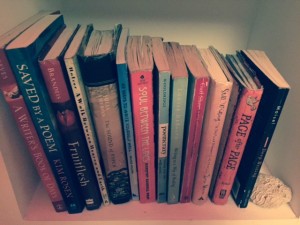
The writer Flannery O’Connor famously said, “If you survived childhood then you have plenty to write about.” Whilst this may very well be true it’s easier said than done to conjure up enough material to keep up the habit of writing a journal. Most people abandon journals with seven days of starting. This may well have been the case with the mother of writer Terry Tempest Williams who gifted her daughter her journals and asked her to promise not to look into the journals until after her death. When her daughter leafed through the three shelves of cloth bound journals every single one of the journals was blank.
The new-year is an ideal time of the year to start a new journal. But most people hesitate because they’re not sure how or where to start, what to should write about and how to keep going.
Over 26 years of writing a journal what has kept me going and got me back on track when I have fallen off the wagon were the book mentors in my collections of books on journaling and creative writing. These are books steeped in the art of journaling or creative writing. I have never felt alone on the journey of journaling as one or more of these books have always been close to hand to dip into for inspiration, ideas and motivation to stay on the page.
With proven physical, psychological and emotional benefits of journal writing being evidenced significantly in recent research giving a gift of a blank journal makes holistic sense. Especially if you want to give someone a gift with personal meaning then a blank journal or notebook with one of my recommended journal writing books from the list below as a companion makes perfect sense.
Starting from left to right:
A Writers Book Of Days, Judy Reeves
Whoever receives this as a gift won’t ever be stuck for something to write about. Reeves, ploughs you with hundreds of writing prompts to keep you going for the year. I love all the quotes about the idiosyncrasies of writers and how they write. The layout is spacious with text that’s easy to read.
Saved By A Poem, Kim Rosen
If you want some fresh or new ideas for writing in your journal then you won’t be disappointed with Saved By A Poem. It’s all about the heart and soul of poetry and how to use a poem to learn about yourself and life. Reading this book inspired me to start learning poems again off by heart. It brings home how poems can connects us to those emotions and feelings we may have difficulty in expressing. This one is ideal for teenagers, someone facing adversity or when you’re feeling adrift in your life or career. There’s a CD that comes with the book of all the featured poems.
Poem Crazy, Susan Goldsmith Wooldridge
I never tire of reading Poem Crazy. Each essay is a deep dive into the wonderful mysterious force of nature that poetry bestows upon us. But it’s not airy-fairy text as each essay features real life situations from the authors work as a poetry teacher. In fact it’s very moving when you realise how deeply poetry can touch and move people and groups whom others have often given up on. This is a playful, fun book, which is also full of surprises. I think reading an essay a day from Poem Crazy will get you to the page and keep you there. The prompts are not what you would expect which keeps the whole process stimulating. I’ve read my copy several times over now and I’m never bored by the content. This one is great gift for a teenager who maybe finding it hard to vocalize experiences and feelings.
Fruitflesh, Gayle Brandeis
The succulent pomegranate on the front of this book was what originally drew me to buying it. But I was bowled away by the richness and juicy writing prompts that focus on writing prompts inspired to get women writing about their bodies. Brandeis writing prompts are refreshingly appetising, savoury and short but yet deep and reflective. Whether you write or not every woman should have a copy of Fruitflesh. Unfortunately someone in marketing made a startling choice and changed the book cover design which I am sure has had an impact on sales of the book.
A Walk Between Heaven and Earth, Burghild Nina Holzer
Don’t be fooled by the slimness of this book. It’s a years worth of journaling by creative writing teacher Burghild Holzer. This is a great companion for someone new to journaling. Holzer shares a year of writing in her journal around the time of her brother dying. It’s an ideal companion to a journal for someone who maybe experiencing grief or loss.
The Sound of Paper, Julia Cameron
I have read every non-fiction book by Julia Cameron and I like them all but the Sound of Paper is one of my favourites. I love the image on the cover and the chunky feel of the book. The essays are beautifully crafted using metaphors of the earth to illustrate the contours of the writing life. I found the essays in The Sound Of Paper meditative and they really inspired me to write more sensually and connect to the senses in my writing.
49 Ways To Write Yourself Well, Jackee Holder
It’s an easy to read illustrated guide to journaling and therapeutic writing. It helps you get started with journaling and offers loads of journal writing prompts. It includes writing exercises to deal with everyday life challenges as well as ideas for becoming a better writer.
Soul Between The Lines, Dorothy Randall Gray
This is one of my favourites. The book is well structured and crafted and the author comes up with some gems for writing a journal and for developing writing practice in your journals. I like the practices of finding “seeds” and the “food for thoughts” in early writing drafts. Come on publishers you need to bring this book back into print. You can still find second hand copies on line.
Writing As A Way Of Healing, Louise de Salvo
This book is a more serious take on the expressive and therapeutic benefits of journal writing and is best suited for those needing to work with emotional and psychological material. It is evidenced based so draws on research and case studies. I like this one a lot and have returned to it many times as research for articles and writing projects. This is a great writing book to gift to a friend or family member who works in the caring or helping professions or someone who is going through a difficult time.
One Continuous Mistake, Gail Sher
This is another slim volume but not to be underestimated. Sher an ordained Buddhist minister has pulled together a volume of Zen like essays on the writing habit. A strong message throughout the book is the reminder that we can learn a great deal from our mistakes. I have been sharing her four noble truths for years with writers on writing retreats and they really resonate with people. This book is both spiritual and sacred. I wrote loads of quotes from this one and kept stopping to follow up references.
Still Writing, Dani Shapiro
This is a new edition to my collection which I read earlier this year and spent most of the time either laughing out loud or nodding my head in agreement. If you know someone who is struggling with believing in themselves as a writer than Shapiro’s down to earth story telling about becoming a writer will kick you up the butt and hopefully onto the page. This book teaches you about writing and life. I loved it, tweeted it and she conversed with me on Twitter. Not bad for a best selling author who’s been featured on Super Soul Sundays with Oprah.
Page By Page, Heather Sellers
I couldn’t believe my luck when I stumbled across Page by Page. Newly in print in 2009 I felt like I had found a new friend. This is a hearty book. It won’t allow you to get off the page. It breaks down the writing process in an easy to follow, friendly way that you leaves you not feeling intimidated by the writing process, I promise you. It’s one of those guides that you know and feel it through the writing that the author has walked her talk. Heather is an experienced writing teacher to writers and it shows. Great book gift for someone who wants to write but hasn’t started.
Deep Writing, Eric Maisel
I really like Eric’s work and his books are always well researched and thought through. Deep writing should get a lot more attention than I think it does. It’s great for those who want to take their writing more seriously and beyond the pages of the journal or seasoned writers who might be feeling stuck. But equally it’s a great guide and companion for deepening into your own journal writing and writing well about the things that are meaningful in life.
1 Comment
Monday, November 17th, 2014
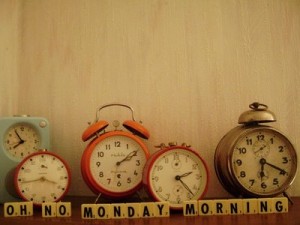
It’s Monday morning and pouring with rain in London town but for a huge majority of the nation Monday mornings feel the same whether it’s raining or not.
One way of getting focus and a dose of free divine guidance tohelp with problems or challenges that might be bothering you on a Monday morning is to indulge in a bit of creative online oracle reading.
I have a collection of card decks that I use for writing inspiration and for help and insights into life’s every day challenges or problems. But decks are not easy to carry around so increasingly I’ve been going online for some of that guidance.
Now I know that for some people the word oracle brings to mind a psychic reading with an older woman in a shawl looking into a crystal ball (well I know in the past it has done for me). Good news is that oracle readings have caught up with modern day technology and brings a fresh new approach to readings making them more accessible, easy to read and understand for yourself. These readings put you n the driving seat.
Instant readings on line can be especially useful when you don’t have access to a coach or mentor, a trusted friend or listening ear, when you want to keep an issue or problem private or you want some new perspectives on an ongoing issue.
Here’s three of my favourites online oracle readings and guess what they’re all free!
Instant Guidance
Rebecca Campbell’s offers one of the best instant guidance readings on line. Always insightful and to the point I like the positive energy and down to earthiness of her readings.
I know Rebecca personally and know that each of her readings have been channeled through her (and they feel like I whenever I hit the button) often as she wanders through Regents Park a stone throws from where she lives in central London.
How it works
- Think about something you need a little bit of guidance with.
- Close your eyes and click on the button for your instant hit.
- You’ll receive an insightful message and guidance that I always find spot on.
Click here for more information about Rebecca Campbell Instant Guidance Readings
A Touch Of Grace
Next on my list for your free online oracle reading is Cheryl Richardson’s Grace cards readings. I first owned the Grace cards as a deck of cards but enjoy the immediacy of having instant access to an online reading even when I’m on the move.
Accessing the cards appear on Richardson’s website in the form of twinkling stars.
You’re guided to click on the Begin logo to receive a divine message.
How it works
- When you’re ready close your eyes and think of a challenge you’re currently facing.
- Then open your eyes and click on the twinkling star that calls to you.
- A card appears with an image and a word.
- You are then invited to contemplate on the word.
- Next click on the card and it will show you a message on the other side of the card.
Click here to find out more about Cheryl Richardson
3 Card Oracle Reading
My final online card reading comes from the Enlightenment pack (another deck in my collection) created by US psychologist Chuck Spezzano.
Click here to link to the 3-card reading on the astrologer Pam Carruthers website
Click here to visit the Psychology of Vision website
How it works
- To begin, think of a current problem (and if you don’t have any problems then think of something you’d like to improve in your life). Or choose a problem you’d like to clear, if not entirely then at least the next layer of it.
- Three cards will appear.
- Pick a card from the first selection, which identifies what the block is. The second card identifies the gift and the third card the healing.
I like the fact that there is an in-depth explanation of each of the cards along with questions and prompts to explore the theme and issue in more depth. You will definitely need pen or paper to hand or copy and paste the text for each of the cards.
These cards take you on an inner journey when you welcome a deeper psychological and spiritual exploration of your issue.
So there you go. You don’t have to have the Monday morning blues with all this instant guidance at your fingertips. So don’t let your problems eat away at you. There’s plenty of inspiration and guidance out there and plenty of it’s available for free.
Have yourselves a great week.
No Comments
Wednesday, August 20th, 2014
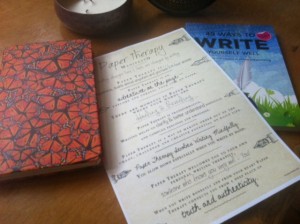
(Quotes in brackets form part of The Paper Therapy Manifesto 2014).
A Manifesto is a personal declaration based on a belief or something that you strongly stand for or advocate
I’ve always been a bit of a writing geek. At secondary school I went to great lengths to design fabulous cover for my history projects as well as illustrating all my content, which always earned me straight A’s in the subject.
In the last few years much of that passion has resurfaced in the creation of a series of manifestos. Manifestos help me to get to the roots of why a particular practice or activity is of value. Then by turning it into a manifesto it becomes a powerful written reminder of why the topic of your manifesto matters. That’s why Paper Therapy has become the fourth in my series of Manifestos. The first three were: The Writing Manifesto, The Creativity Manifesto and The Nature Manifesto, which you can download for free by clicking on the links.
The new hot off the press Paper therapy Manifesto is a call to the magnetic practice of journal writing based on my belief that (Writing changes lives and lives are changed by writing).
I’ve been journal writing for over 26 years. I started writing regularly in a journal a year or so before my daughter Aida was born. Over the years journal writing has helped me through various bouts of depression, a serious broken heart, a meltdown around my career, financial hardship and the high’s and lows, swings and roundabouts of daily living (Paper Therapy is Transformative. Writing helps to clarify and better understand difficult feelings and emotions).
The practice of journal writing has become both a daily ritual and a place where the quiet practice of journal writing returns me every time quietly to myself. It’s where I get to express myself, to hear and listen to my inner voice and not get carried away by the hustle and bustle of the world around me (There are moments in Paper Therapy when your words are healing and revealing).
What I appreciate about the practice of Paper Therapy which journal writing is part of is that (Paper Therapy is inexpensive, doable almost anywhere and you have 24 hour access). I like the fact that it’s possible to engage in paper therapy almost anywhere, from the top of the 37 bus, at the wheel of my car, in a park under a tree, in a corner in a busy café or scribbling in the dark of the local cinema screen
I find the regular practice of journal writing both therapeutic and calming. It takes me out of the roller coaster world of the busy mind and transports me into the world of quiet mind in minutes (Paper therapy involves writing mindfully. You slow down especially when you write by hand).
Sometimes I write loads in my journal, flushing out all the toxins and negativity from my day. On other days it’s just a sentence or two to remind that I’m still here. Most of the time because of it becoming a practice the page is alight with ideas, musings, seeds of thoughts and possibilities about life and work (When you write honestly and from your heart Paper Therapy connects yourself and others from a deep place of truth and authenticity).
In my world Paper Therapy embraces the ordinariness of life, sharpening the quality of my awareness and presence
(Paper Therapy is an adventure on the page – Explore and unravel your life on the page). In-between jottings of deep reflective thoughts and inquiry you’re just as likely to stumble across a shopping list with items like cod and potatoes. The sacred and the routine sit side by side.
There’s no showing off or points to prove in the journal (what’s the point), only showing up. We get to show up, as we are. If we’re brave enough and honest enough, we show up sometimes naked, without the buffing up, the job title or choosing the option of hiding behind material possessions. Instead it becomes just you and the blank page, (Paper Therapy welcomes you to your own personal writing therapist, someone who knows you very well).
The writer Flannery O’Connor said, “If we survived childhood then we have enough material to last a lifetime.” Put this together with some wise words from Ernest Hemingway, “ The world breaks everyone and afterwards many are strong at the broken places,” so the fact that you’re alive means you have enough material to write about in your journal or notebook to last you a lifetime.
In a recent blog post for the entheos academy author Mozart Gurrier shared an example about children in a homeless centre where the facilitator sets a chimer for three minutes and gets them to write. Read more here
This is a brilliant example of where an organization has embraced the practice of #papertherapy.
- Think about what and how our schools would be different if students were given 7 minutes at the start of the school day to getting their feelings down either digitally or on paper in a session rightly named #PaperTherapy.
- How much more and aware and in tune would our teaching staff be all round if permitted to do the same?
- Think about the conflicts, the bullying and harassment that would be eradicated workplaces if people learnt the rules of engagement with the blank page that showed them how to take ownership of their own emotions and feelings (Paper Therapy is a way of making order out of the chaos and challenge of everyday life).
They would learn how not to spill and leak emotions all over the place a point eloquently illustrated by the writer Alexandra Johnson in her book, Leaving A Trace: On Keeping A Journal. Alexandra shares some of the possible pitfalls for those not used to keeping a journal when she writes “Trust that the bore bending your ear on the plane or the ranting taxi driver on the ride home never kept a journal. That egotism leaks out publicly instead. You become their journal, a live blank page, held hostage in a seat. Think of journals as a safe, private way to have it siphoned off, rethought, vented … “
- Think about how much money and pain would be saved in divorce settlements and child custody cases if parents and families learnt how to make paper therapy a way of family life?
- Prescriptions for anti-depressants in the UK has increased by 495 percent since 1991 (Huffington, 2013). What if GP’s handed out paper therapy prescriptions instead of tranquillizers or encouraged patients to put pen to paper? And what if Dr’s self -prescribed some of the same paper therapy as they prescribed to their patients?
- What if healing and restorative poems from across the ages and modern times were available free of charge on the NHS? Numerous research is indicating that reading poetry creates new neural pathways in the brain.
Paper therapy works for me however it doesn’t make my life perfect. I still have to deal with messy stuff like everyone else does. I make mistakes, get things wrong and piss people off! But perhaps this quote from the book, The Pen and The Bell: Mindful Writing In A Busy World will give you a better understanding of how journal writing has contributed to me becoming a much better person in my life than the person I would have been had I not embraced it as a practice.
Writer Kim Stafford likens writing to playing the violin. He says that a violin played everyday will keep the vibration of the music in its body, even while lying still and silent. If it is not played everyday the vibrations dissipate and the wood grows lifeless.” Journal writing gives my life vibration.
The other aspect of journal writing I wholeheartedly appreciate right down to the bones about it as a practice and a way of life is how I have grown to love fiercely the woman who has inhabited the thousands of pages of journals and notebooks that I’ve filled.
My Paper therapy journey has been like a seed planted in the earth. Every word, every paragraph and every line has been turned over and mulched into the fabric of my daily life. The pages of my journal have been the earth and the soil in which I have grown. Each journal from cover to cover has watered my life. Nothing I’ve written has been wasted.
When I don’t write regularly, when writing is not at the core of my life it feels as if I’m skimming over the surface of life. When I write often and regularly I’m noticing how my hunger for the things in life that are addictive and unhealthy is greatly reduced. My digestion of everyday experiences is clearer and more of a felt and lived experience when I write.
Through the paper therapy journey I’ve grown to accept and not reject the woman I have blossomed into warts and all.
Welcome to #papertherapy. Let the writing and the inside out change process begin. I want to be part of a revolution on the page knowing that (writing changes lives and lives are changed by writing). Will you join me?
Download your free copies of the Paper Therapy Manifesto 2014 here:
If you are inspired please feel free to spread the word and share the love.
With Love,
Jackee
No Comments
Sunday, August 10th, 2014
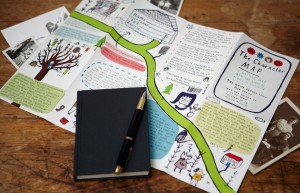
The Character Writing Map: Click here
I love it when I come across new, juicy resources for writing that make getting onto the page a more enjoyable process. With our busy lives it can be so easy to run ourselves ragged and have very little time for the writing process. That’s why I was delighted to come across Shaun Levin’s Writing Maps. I purchased eight in one day simply because they are so good as visual, illustrated writing prompts for fiction and non-fiction writers.
I’ve know Shaun for a few years now and was excited when he agreed to be featured on the blog as a guest blogger talking about Writing Maps. We share a love of paper and I love how the Writing Maps emerged from his Inquiry question about ‘What next in his journey as a writer?’
Read on to hear what the fab Shaun Levin has to say about Writing Maps and how they creatively nourish and inspire our writing:
I suppose the Writing Maps are a way for me to take stock of 20 years of teaching and running workshops in all sorts of settings: colleges, universities, schools, as well as more public spaces, like art galleries, parks, cafes, department stores, a zoo, a cemetery, on a boat.
Much of the material for my teaching comes out of my own practice as a writer and very crafty techniques for combating my own resistance to actually sitting down to write! I’d say that most of my work has been written outdoors, or at least started when I was away from my desk, out of the house, in cafes and on park benches pretending I wasn’t actually “working”.
And then there’s my fascination with the combining of text and image. And my interest in psychogeography and creative mapping. I don’t remember exactly how it all became aligned, but at some point I must have thought: let’s put creative writing prompts onto maps! It was a bit of a eureka moment!
To be honest, I think the Writing Maps also started at a time when I wanted something new, to try new things. I was about to turn 50 and was questioning a lot of what I was doing, asking myself whether this was it, whether I would just keep doing the same thing for the next 50 years, publishing another book, teaching another workshop, publishing another book, etc.
I know that if you’re a writer then that’s what one does, but I was questioning that! Working with a range of different designers on the Maps has given me more confidence to explore my own very limited illustration skills and to kind of enjoy the beginner-mindness of something I’ve never done before but have always wanted to.
Drawing! Visual art has been a huge part of my work for the past 10 years – I’ve been writing about painters, researching painters, visiting artists’ studios, but never really giving myself license to explore the challenge of creating without words. So that’s all been exciting and new and who knows where it will lead!
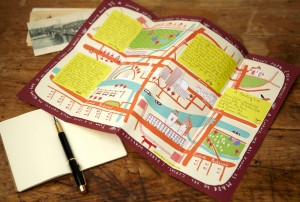
The City Of Inspiration Writing Map: Click here
Talking about new things… In March this year (2014) I started a monthly writing contest that links to the launch of a new Writing Map each month. The first 12 winners (two from each month) will be published in a new literary magazine that’ll launch in September. It’ll be called A3 and will be on an A3 page, like the maps, and will fold down to A6 (postcard size).
Maybe it has something to do with the way we carry our phones around with us, so much of what matters to us is in this one device… so the Writing Maps and the new literary magazine will be things you can carry around with you. I guess it’s my love of paper combined with the convenience of having inspiration and beautiful things with you at all times.
Publishing other people’s work, which I’ve been doing for over ten years, has always been about sharing exciting work that I’ve come across. Like, look at this amazing bit of writing I’ve just read! So the new journal will be very much about that. Often the most powerful writing comes out in the shortest time. It always energises me when you give people in a workshop a really simple prompt and in 5 or 10 minutes they create this moving and surprising work.
I want the Writing Maps to inspire that kind of writing! I’d love them to be the thing you carry with you wherever you go. I want the Writing Maps to inspire people to write stories or explore in deeper ways the stories they’re working on.
The whole idea behind Writing Maps is that the world out there is full of inspiration, that basically the world is one big creative writing (or drawing, or painting) prompt, and the Maps are made up of suggestions to channel that into stories, to make stuff out of what’s already there! Writing Maps are for anyone who is interested in writing and who is open to trying out new approaches to creating stories.
I think writers are always looking for new ideas for stories, or an interesting way to tell the next story, so hopefully the creative writing prompts Writing Maps will open up new possibilities for writing adventures.
About Shaun
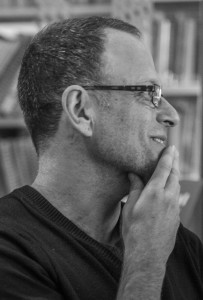
Shaun Levin is the author of five books, amongst them: Seven Sweet Things, Snapshots of The Boy and A Year of Two Summers.
His fictional work on the poet and painter Isaac Rosenberg has recently been translated into French and will be appearing in September 2014. His short stories and essays appear in over 50 anthologies and journals, and he was the founding editor of the literary and arts magazine, Chroma.
He launched Writing Maps in 2012, and is about to launch a new literary journal, A3.
No Comments
Thursday, August 7th, 2014
Welcome to the new PAPER THERAPY MANIFESTO. We hope you’ll enjoy using it.
Download your copy here.
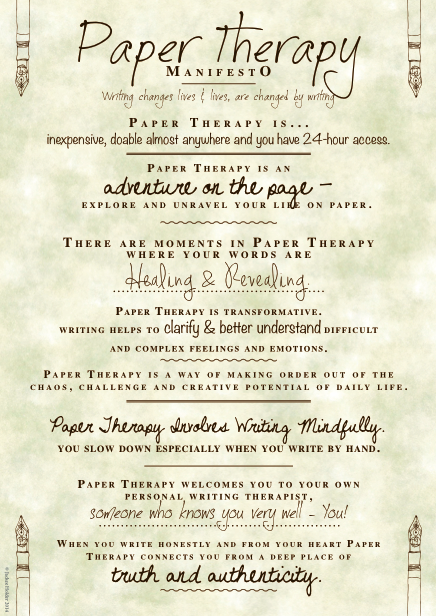
1 Comment
Sunday, August 3rd, 2014
My friend and fellow author Ji Hyang Padma author of the lovely book, Living The Season: Zen Practice For Transformative Times recently invited me to take part in a “Blog Hop”. It required answering some thoughtful questions on my writing life. Here’s what I had to say and a link to her blog, Natural Wisdom

What am I writing/working on?
When it comes to writing I’m always working on something or other, whether it’s personal writing or writing for publication. Writing creatively in some form or shape is an everyday occurrence. I do feel lost without my journal, a blank index card or the Notes app on my iphone.
At the moment I have several writing projects on the go and many that are near completion or needing to meet a current deadline.
These include: Two articles for a print journal and an online magazine. The topics are: Exploring the impact of race and diversity in coaching and the second is a feature on Mindfulness for women.
I’m just putting the finishing touches to my latest Manifesto, Paper Therapy. We did have an original design but it didn’t make my heart sing so I put it away for a few weeks and then the other day on my travels I came across a design that gave me the ideas for a new look for the Manifesto which I now love. It’s just in time for a workshop I will be delivering at a summer well being festival here in the UK.
I have two online courses that I’ve written which require tying up loose ends and I’ve gifted myself the month of August to birth both of these projects. This is both an exciting and scary time for me as it is taking my work into new arenas. So watch this space.
As usual I’m late in completing the content for my website’s monthly newsletter. I just never seem to be able to generate this in advance. I’ve tried programming the topics in advance for the year but it felt really stilted and I found the writing didn’t flow. But part of me knows that I enjoy working close to the bone so I’m kind of accepting this and not nagging myself about it too much.
I’m playing with the idea of a submission of a ‘Wild Bio’ to a website where I can share more of who I am with a wider audience and an article/blog post on the writing retreat I led in Greece at the end of June, early July. I’ve been sitting with the idea for a few months now and the time now feels right.
I am off for the month of August, which I’ve dedicated as a month of writing. I’ll be staying in London but have planned to explore and hang out in as many London hotspots in nature and culturally as possible. • During my writing vacation I’ve set an intention to leisurely draft the synopsis for my new book whilst wandering and exploring. I’ve given myself permission to be relaxed about this. I’m not one of those writers who can write a book in 90 days. I need time and space and creative oxygen.
How does my work differ from others of its genre?
Personally I feel I have risen to my own personal challenge of breaking down that barrier of an assumption I carried that to be a coach who works in the corporate sector I have to present a certain professional image (what a load of crap). My challenge to myself was to be brave enough to talk and write about all aspects of my life and expose this on social media. This includes writing about spirituality, the creative process, mysticism and all things alternative that I have something to say about.
There was a time I believed this would go against me. Was it credible to call myself an executive coach and then in the next breath write blog posts about trees, poetry and sacred spaces? Was it okay to disclose that I have over a hundred journals, that I was ordained as an interfaith minister and that I love candles, incense and the moon?
Now I realize the gift writing continuously offers me is to not hide those valuable and essentials parts of the self. The more willing I am to reveal all of who I am including the shadow selves and vulnerabilities that are all a part of me, the more I connect to my wholeness. The better placed I am to model that for others, hopefully offering them permission to do the same. At the end of the day we attract the people and organizations that resonate with how we show up. We all have a magnetic transmission to attract our signature tribe. The key is to be authentic in your own unique way and that is what I aim for as well as I can on any given day.
Why do I write what I write?
On a daily basis I am inspired by nature and the creative process and how this influences our inner lives. I do not see this as separate from my work as a professional coach and speaker. I’m very connected to life’s finer detail, the subtleties, the deeper meaning of life. I capture much of what I see observe, sense, smell, hear and experience in my journal and notebooks.
This habit has helped me stay grounded, strengthen my resilience and expand the reach of my resourcefulness, which often generates a state of peace and calm even when things are turbulent and stressful. Noticing and writing about what I see, sense and observe as I go through my day brings life into full view.
I like that I have this private and wild world inside me that I can make sense of and integrate this into who I am being in all the different roles and persona’s that shape who I am in the world.
Writing helps me to bring both the inner and outer selves into greater alignment. I write about what I often do not say or share in public, in conversations and in relationships. Writing is my way of expressing my voice to myself so when I write I get to listen to myself first. It is a wider exploration of who I am that is often not afforded space in everyday interactions and conversations.
Writing provides a more fertile ground for what I want to say and who I want to be outside of my writing. How does my writing process work? I’m particularly skilled and confident about writing in-between the gaps during my day. By this I mean I don’t have to have designated set times and places to write. As soon as an opportunity to write shows up, I’ll grab it. Most mornings I write Morning pages as a way of clearing my psychological and emotional space. I find this extremely helpful and an affirming way of starting my day.
When it comes to writing projects I’m an advocate of writing those ‘shitty first drafts’. Getting anything down is a sign that I’m willing and ready to get going no matter how awful what I write is. This has served me a thousand times over and is the reason a body of writing work has developed and grown over the years.
I find the craft of shaping and moulding what I write satisfying even when the writing itself feels cumbersome and challenging (which it often does). I’m always trying to find that sentence or idea that I know will hit the right note or help the writing to sing. I guess I see and experience every piece of writing as a possible gift. There’s always the potential that somebody, somewhere will be touched by something that we write or share. This way I can give my work away knowing that it will find its way into the right pair of hand and eyes.
I have had the odd occasion where I have read a past journal entry in my own journal and thought how on point the person was who wrote the quote only to realize I was the author. This is an act of grace and humility and reverence for the writing process. We never really know what might be revealed that will surprise and astonish us, often when we least expect it.
I use everyday household duties as meaningful time for my ideas to percolate. The rhythm of routines like hovering, folding the clothes, filling my papers means my mind is free to go to work on bringing together and connecting ideas, firming up sentences and themes and creating structure and form so that when I arrive at the blank page or computer screen there is something there, a hook, a place to begin.
But then there are times when a writing deadline does not provide time for this kind of wandering without an agenda or a destination. This is when I write without knowing what will come and the writing guides me and shows me what wants to be written.
I’m a firm believer that writing as an art form is a mysterious process full of magic and wisdom that is greater than us. Other times writing pieces and projects are pieced together from scraps of paper, seeds from entries in my journals and notebooks or inspired ideas from quotes and books.
Some of the quotes I’ve collected on index cards go back years. I have an ability to remember a quote from ten years and can photographically recall the colour of the index card I wrote the quote on and what box it might be housed in. I’m accurate 98 per cent of the time.
I’m really motivated and energized to write when I’m traveling on trains, buses and driving in my car. I often park on quiet roads and write at the wheel. Or I park up early outside the train station before heading off to work and write my morning pages.
Everything around me is possible material for all of my writing and much of my writing is heavily influenced by what I experience in my day-to-day interactions.
I draw inspiration from beyond traditional and expected places like books, libraries or the internet. Inspiration and ideas can get sparked from a comment on the radio, a slogan on a billboard, a piece of overheard dialogue on the subway or dialogue and information gleaned from television or a movie. But I need to be receptive and open to receive, to notice and to capture it before it disappears and is forgotten. So I always have pen, paper or fingertips ready to get moving.
If you would like to read Ji Hyang’s “Blog Hop” response please click here to read and find out more about the wonderful work and teaching she’s doing.
What are some of the blogs you read?
Click to follow the links and read more:
The Vulnerability Project Click here , Laurie Wagner Wild Writing click here , Rebecca Campbell The Spirited Project click here , Suzette Clough Visual Medicine click here and Esme Wang click here
No Comments
Friday, July 11th, 2014
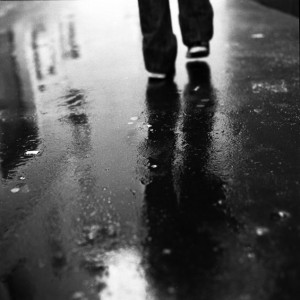
credit Chobonaut
This morning despite the pouring rain I set off on my morning walk. I did look like I was dressed for the North Pole with two hoodies on tied up as far up my neck as possible.
The rain was heavy and the walk was a soggy plod up the hill and then onto the main road as I walked the route that would take me around 50 minutes back home.
Whilst walking I got lost in my thoughts and one of those thoughts was how often I don’t feel like writing and that it regularly feels sluggish and slow and doesn’t make much sense. A bit like how I was feeling in the rain this morning. But once I got into my stride, despite the rain pelting down I began to not even feel or notice the rain.
Instead I became more aware of my environment. My nose tingled at the woody scent of the man’s aftershave who walked past me at the bus stop. I began turning over a difficult personal challenge I need to try and resolve between family members and I smiled at the numbers of people I passed without coats, jackets or an umbrella in sight who I guess have some secret weather forecast that the rest of us know nothing about.
Sometimes writing feels awkward and clumsy to begin with. You definitely don’t feel like doing it but you hit the page anyway. But even then nothing you write seems to make much sense but you keep going and then at some point often when you least expect it you hit a word or sentence or maybe an idea that contains a seed of something, that leads to another thought or idea. And like I experienced on my walk this morning you start to loosen up.
About ten minutes into my walk I unzipped one of my hoodies. I’d started getting hot and my pace quickened. At the same time without any deliberate effort I came up with an idea for the family dilemma. I’d found a groove despite the rain and the damp weather.
For years writers have been telling us that rough drafts work. Rough drafts get us going as choreographer Twyla Tharp commented on in her book, The Creative Habit, “Starting is not the same as beginning.” But too often we’re over ruled by the cultural pressure that sends out the message that from the word go we somehow need to be perfect on the page, first time round. We stress ourselves out by believing that those first rough drafts need to arrive on the page as polished pieces. Nothing could be further from the truth.
Messy, incoherent writing is often what gets us going and is the place we start from that will eventually if we persevere and stay with it that leads to a finished article, that post for your blog, the first chapter of a novel or short story, the report for work or an entry in your journal or notebook.
If you’d like some support with how to get going with your writing, or how to stay with it then over the summer there’s opportunities to attend the following workshops with me where I will share tips and techniques for getting starting and staying on the page.
On 24th July I’ll be leading an evening workshop entitled from Zero To Hero click here for more details: https://www.eventbrite.co.uk/e/from-zero-to-hero-how-to-start-writing-with-confidence-with-jackee-holder-tickets-12164637759?ref=estw
On August 8th I’ll be in Oxford leading a Paper Therapy workshop at the Wilderness Festival http://www.wildernessfestival.com/programme/now-live-events/ One on one slots with me are also available at the festival.
Finally if you’d like to spend a day with me I’ll be leading a one day Write Yourself Well workshop (based on my book 49 Ways To Write Yourself Well) on October 11th for Alternatives http://alternativesevents.org.uk/event/jackee-holder-write-yourself-well/
No Comments
Tuesday, June 24th, 2014
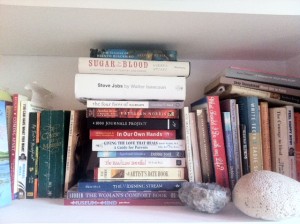
In 2011 the self-help book industry in the UK was estimated to be worth at least 6 million pounds, whilst in the US its value was around the 10 billion dollar mark.
I’m one of those millions of readers who have invested significantly in both of these markets. Over the course of twenty years I’ve deposited at least £5,000 of my personal income into purchasing hundreds of self-help and non-fiction books, which now fill one and half rooms of my home in South London and growing.
But is this a chronic case of shelf development or self-development? A point brought home recently at a talk the editor in chief of the Huffington Post, Arianna Huffington gave in London.
The question posed by a woman journalist in the audience went something like this, “with all of this information and articles on well-being most people aren’t doing anything with what they’re reading.”
I sensed an air of unease amongst the audience as she launched into a long, rambling and sometimes repetitive explanation, which despite its obvious flaws in presentation was at the core, a great question.
Her question played on my mind on the drive home from the event. It was a question I had posed to myself many times before particularly when remembering the over burdened shelves of books in the two rooms in my home, claiming every imaginable wall and shelf space.
The question begging an answer was, “How much had I really changed as a result of the hundreds of books I’ve read over the years?”
Had I really been conning myself? Had I grown victim to giving away money that simply wasn’t worth the paper it was written on? And if my self-help book addiction was anything to go by, maybe I had fallen victim to what Professor Timothy D. Wilson describes as the 18 month rule – which is the person most likely to buy a book this week is someone who bought one 18 months earlier. Only my gap between purchases was more like two weeks than 18 months.
So how can you ensure your self-help books don’t end up as shelf development?
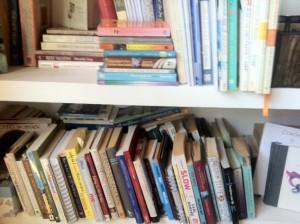
1. Choose self-help books, which include research of some kind to evidence the techniques and models presented. Two of my four books contain references to research. 49 Ways To Write Yourself Well, my third book is based primarily on research into the therapeutic benefits of writing.
I remember one of the first comments the course director, Simon Western on my post graduate qualification in coaching at Lancaster University made to our group was that, “ too many coaches had abandoned, left brain, critical thinking in favor of right brained, positive thinking, but we need both.”
I think the same is true of the self-help industry. For self-help books to not sink but swim then they need to include research and scientific data that validates the content and numerous claims made.
2. The majority of self-help books glibly evade writing about and helping the reader accept that pain is part of life and avoid dispensing tried and tested advice on how to respond and be with pain.
Self-help books that tell the truth are empowering. Trying to gloss over life with suggestions and activities that are surface level is both ineffective and unreal.
Author of one of the more recent best selling self-help books, This is How, by Augusten Burroughs (which by the way I do recommend) describes this as, “So certain feelings are denied. Which is something like believing your house is clean as long as you don’t peek under the bed.”
According to psychologist Oliver Burkeman, “instead of trying to psych yourself up into the right mood to act, learn to act alongside whatever mood you’re in.”
3. Be willing to put in the work. Most of the time it’s not that a self-help book doesn’t work. It’s that we don’t do the work that will bring about the change. “Real optimism is not the pep talk you give yourself. It is earned through the labor of emotional housekeeping,” writes Augusten Burroughs in,This Is How.
We kid ourselves that the sheer act of reading alone will somehow miraculously improve our lives and fix us in an instant without the need to lift a finger.
Some books do put me in a hypnotic trance for a moment or two (think Saved By A Poem by Kim Rosen and One Continuous Mistake by Gail Sher) but the trance soon wears off and then the challenge is to get down to work.
Fear is often the cause of our resistance to putting in the work. In her chapter, Reflections On Learning To Work, included in the book,Working It Out, psycholinguist, Virginia Valian describes our obsession with speed and production, “The culture decrees that you should do what you are good at, rather than what you most like to do; that what you produce rather than what you get out of what you produce is what counts; ….”
So often it is the application, what you get out of what you produce [or do] that creates the change or shift.
The introduction to Valian’s chapter gets straight to the point, letting the reader know exactly what reading the chapter will not do. “It will not remove your self doubts, resolve your inner conflicts, wipe away your anxieties, or eliminates your periods of mental paralysis. It will not wave a magic wand and turn you into someone who works effortlessly for hours everyday.” More self-help books should come clean like Valian does.
4. The best self-help books will address relapses and setbacks as well as provide you with further information on where to gain professional support on taking the work further.
Seek out books that include all of the above and next to your book make sure there’s pen, paper, notebook or your digital recording device. Make a note of all the actions you take and record the impact no matter how small.
As Mark Matousek, author of, When You’re Falling Dive said in a recent workshop, “dig in one place.”
I suggest to you and to myself to read a self-help book as if you’re digging in one place. Give it your full attention and focus. Test out the suggestions. Make a note of what works and do more of it.
Maybe there’s one suggestion in the book that turns out to be a real gem. Hold onto it, discard the rest and start applying what works.
As they say you can take a horse to water but you can’t make it drink. One could say the same for all the books in my collection. Put it this way if I was forced to choose a handful of books from my collection to take with me to a desert island you can bet it will be those titles where I’ve continuously put in the work, reflected on my actions and made changes and shifts as a result.
What’s the one self help book that has had the greatest impact on your life to date?
My answer:The Artist’s Way by Julia Cameron
Why: The practice of Morning pages has become a way of life for the last twenty years and is at the roots of my tag line for my business: Writing changes lives and lives, are changed by writing.
No Comments
Friday, June 20th, 2014
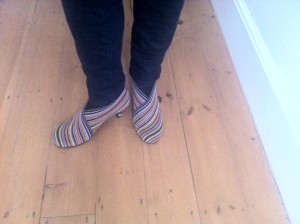
My coaching client arrived for her coaching session in this amazing pair of shoes which, caught my eye the moment she walked in the door. Not only do I love the colours and the style but I also have the same pair of shoes but in different colours. In case you’re wondering where to find a pair here’s the link:
As we admired her gorgeous pair of shoes she let me know that these were called her ‘Inspirational Shoes’. She wears them when she wants to be inspired and feel uplifted. I get it!
- I’m curious about what item of clothing do you wear that gives you that lift?
- What items of clothing or outfits make you not only look good but feel good?
- Do you have a lucky outfit for interviews and important events?
- Is there a psychology behind some of the clothes that we wear?
I’d love to hear your thoughts.
No Comments

